The Microsoft Surface Pro 4 Review: Raising The Bar
by Brett Howse on October 21, 2015 9:00 AM ESTSystem Performance - Testing Skylake
Although the Skylake U-series processors were announced a while ago, until now we’ve yet to get our hands on any devices that are actually shipping with it. Much like the Surface 3, Microsoft is one of the first out of the gate with a new processor from Intel which I think is a good sign for the future. If you want to check out all of the details of Skylake-U, check out the architecture analysis here.
The Surface Pro 4 model that I was sampled has the middle-tier processor which I think is going to be the most popular one with customers. The i5-6300U is a dual-core processor with Hyperthreading, and it has a 2.4 GHz base frequency with turbo up to 3 GHz. Being a U-series processor, it has a TDP of 15 Watts.
The Surface Pro 4 was run through our standard notebook workloads and we can compare some of the scores to tablets as well. Ultimately there just are not enough good cross platform Windows and Android/iOS benchmarks to get a great feel for general system performance versus tablets not running Windows, but we will show what we can.
Tablet Performance
To compare the Surface 4 to other tablets' CPU performance we have the various web based browser tests. These are not always the greatest because JavaScript performance is heavily dependent on the browser used, but they none-the-less represent a collection of common functions that browsers excute from phone to desktop and everything in between. We’ve generally used the latest version of Google Chrome for our web tests since Internet Explorer has very poor JavaScript performance, but with the release of Windows 10 I’ve moved over to Microsoft Edge. It generally performs as well or better than Chrome with the exception of the WebXPRT test where it is a bit behind.

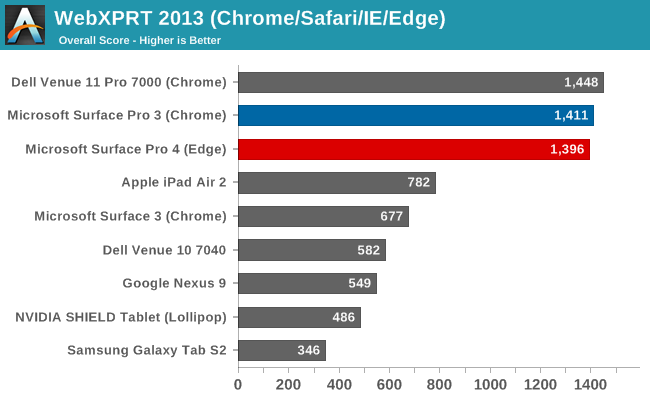
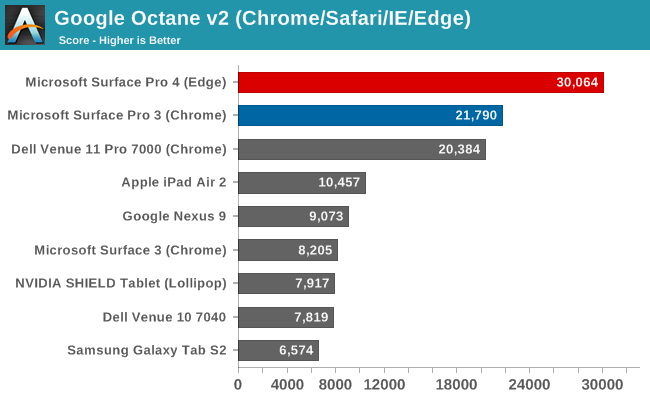
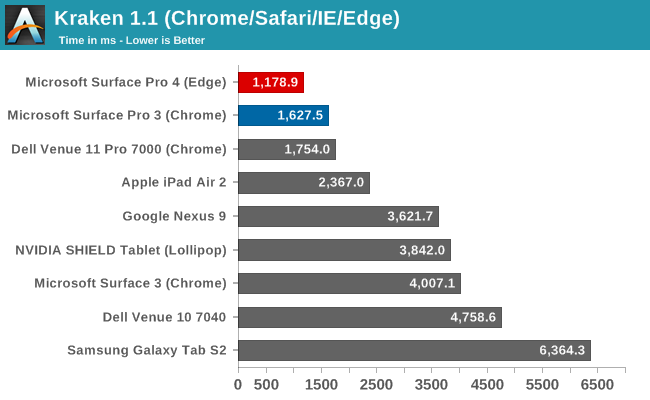
As far as tablets go, there is really nothing that comes close to the performance of Surface Pro 4. A full 15 Watt CPU (even in such a small package) affords quite a bit more performance than anything based on lower TDP ARM chips. Skylake shows some great numbers here.
Notebook Performance
Next up are the notebook workloads. Since the Surface Pro 4 is clearly aimed at Ultrabooks it has to be tested against them as well. Luckily on Windows there are plenty of options for testing performance and it is a true comparison since we don’t have to deal with comparing across platforms.
PCMark
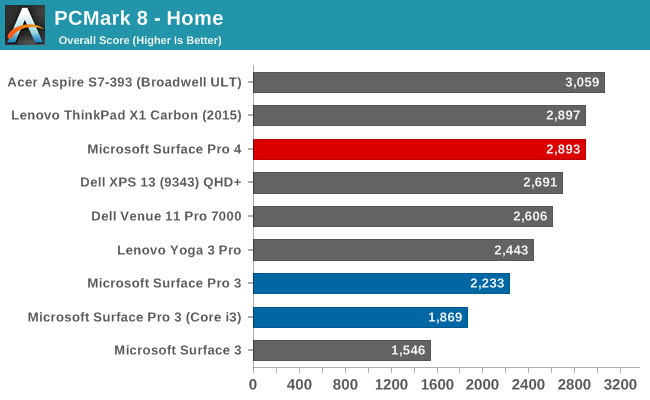
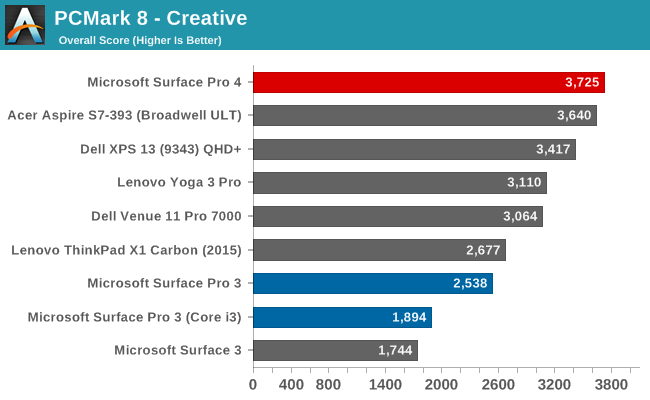
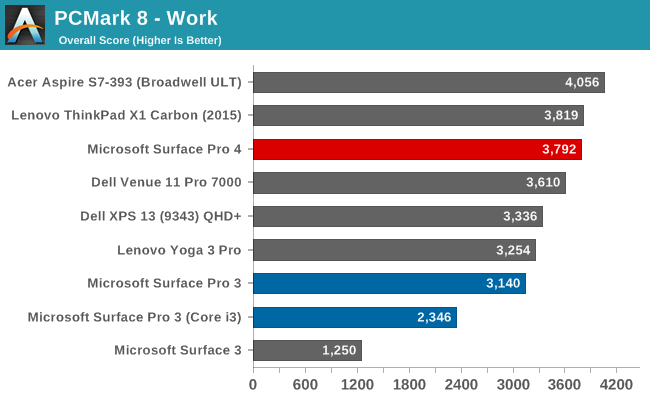
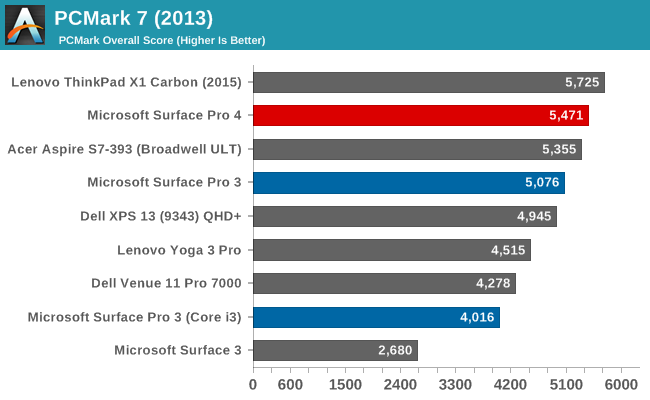
PCMark is a nice comprehensive benchmark which attempts to simulate real world workloads. Some of the tests require burst performance, some require sustained performance, and other factors like the GPU and even the display resolution come into play. The Surface Pro 4 does very well in these tests with the i5 version having as good or better performance than some of the i7 Broadwell Ultrabooks. The high resolution can hurt the scores but they are still very good.
Cinebench
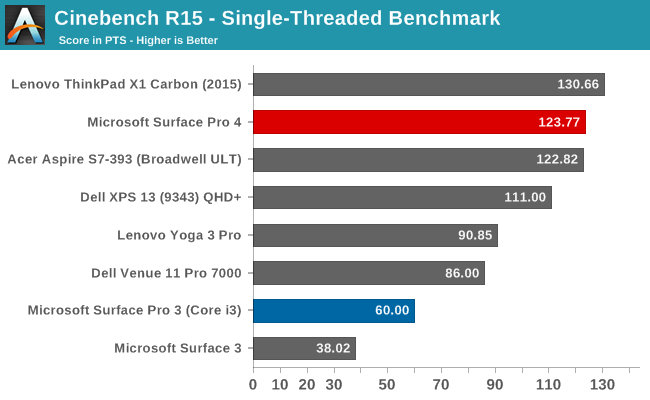
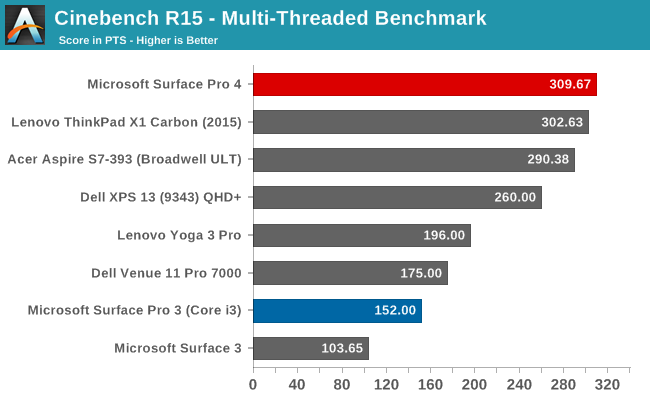
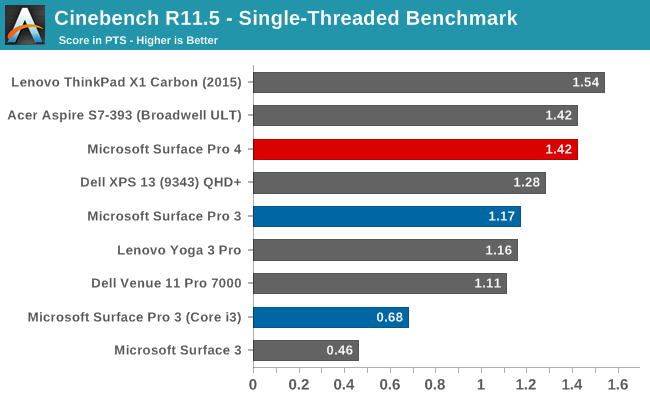
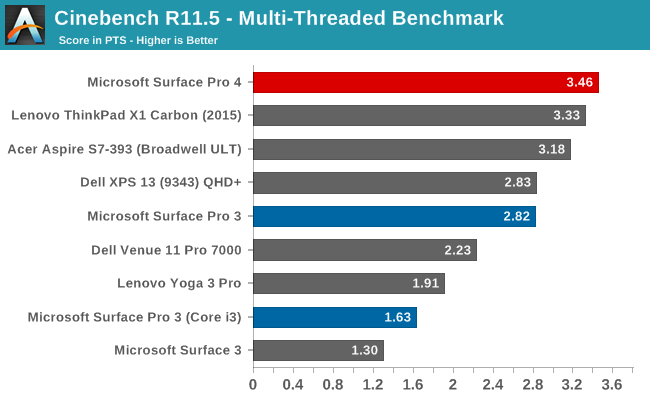
Cinebench does rendering on the CPU and loads the CPU to 100% for the duration. Higher frequencies and more cores can make a significant difference especially on the multi-threaded run of this test. Here we can see Skylake gets a fairly modest increase in performance over the Broadwell including the i7-5600U in the X1 Carbon. Multi-threaded workloads have gained the most. Compared to Surface Pro 3 which has an i5-4300U Haswell chip, the multi-threaded increase is 22.7% and the single-core score is increased 21.4%. A 20% gain over the previous model is a pretty nice amount.
x264
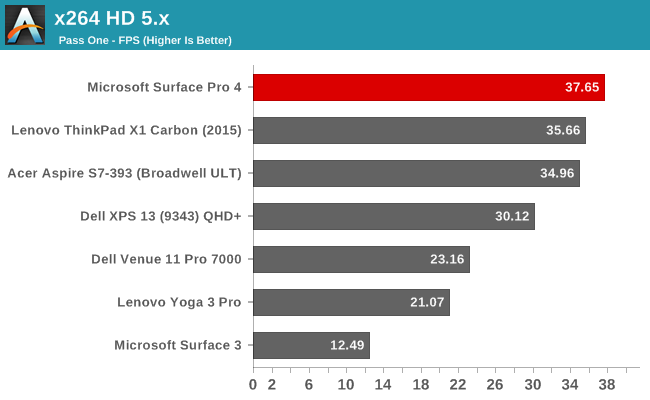
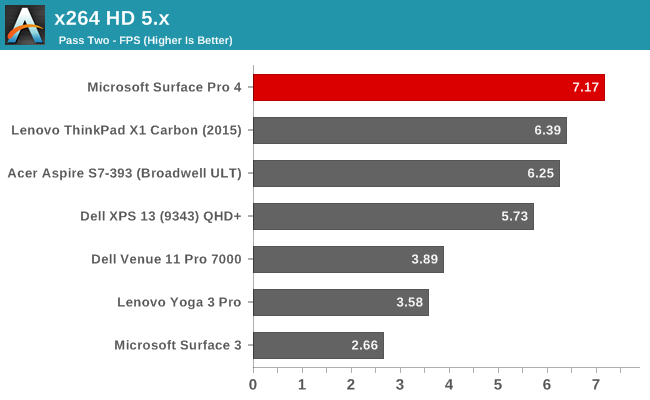
Once again this test is very much based on CPU performance. More cores and faster frequencies can make a big difference on this test, and Skylake shows another nice boost over Broadwell. It’s quicker than the i7-5600U in this test as well. Skylake didn’t get a big boost in IPC, but the efficiencies built in allow it to turbo better and longer. Not too shabby.
Web Benchmarks
Once again we can take a look at browser benchmarks, but this time comparing the scores amongst other notebooks. The tests on the Surface Pro 4 were done with Edge as the browser, and most of the others with the exception of the Acer S7 were done with Google Chrome.

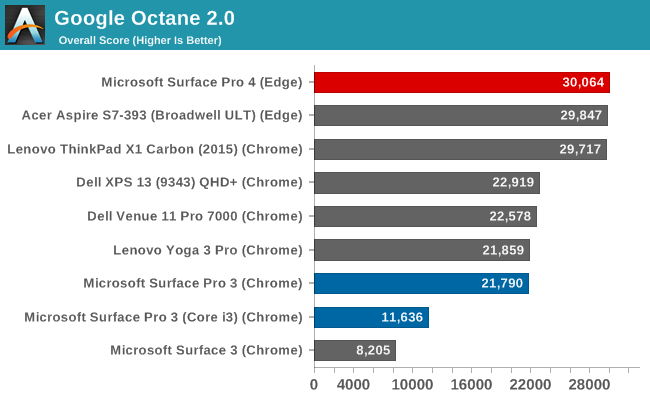
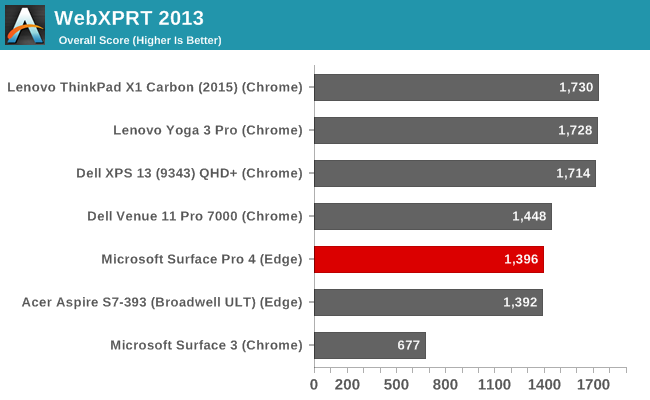
Once again the i5-6300U shows great performance in the web benchmarks. WebXPRT is the one test that Chrome shows a gain over, but since Edge is the browser that ships with the device, that is the one I want to use now that it has competitive scripting performance.
Overall, the change to Skylake has made a pretty nice jump in performance with the Surface Pro 4. The Intel Core i5-6300U manages to pretty much outperform the Broadwell Core i7-5600U in multi-threaded tests, and single-threaded workloads come in pretty close to the higher clocked Broadwell i7. The performance difference from Surface Pro 3’s Haswell Core i5-4300U is even larger.










175 Comments
View All Comments
Mushkins - Wednesday, October 21, 2015 - link
"It is a 2x2:2 802.11ac card, and it appears to be the exact same card used on the Surface Pro 3."Great, so it's going to require a restart every other day when your wireless starts transferring slower than dial-up for no apparent reason. If there was *one* piece of hardware they seriously needed to re-evaluate in these great devices, it was the crapola wireless cards they put in them.
Gunbuster - Thursday, October 22, 2015 - link
This! This! So much this. Did someone accidentally buy a billion Avastar chips back in the Surface Pro 1 days? It's incomprehensible.adrians - Thursday, October 22, 2015 - link
I haven't had any issues with my SP3 and two different routers. Please don't assume that it's a widespread problem just because it happens to you and a few others. Think about all the users who have an SP3 and don't complain because everything's fine. Try switching your router. Also try connecting on the 5GHz band instead of the 2.4GHz band (if your router supports dual bands) since the 2.4 band is more prone to interference from microwave ovens, portable phones, remote controlled toys and other devices that operate around that frequency. Even if you don't have these, your neighbors might and could affect your connectivity. Another thing to play with is the channel your router is using. People often leave this on default and this can lead to very bad connectivity when a bunch of routers around you suddenly are more heavily used during peak times. There are apps (both desktop and mobile) you can use to determine the best channel to use at your particular location and at a certain time. If you do use one of these, just make sure that you are comparing the actual band (2.4/5) you will be using with the SP3.Gunbuster - Friday, October 23, 2015 - link
Yes select the band. the single feature they added to the driver at around fix attempt 12.It's a high end device and it derps along on my 5Ghz (after setting it on a separate SSID because it has no clue on dual homed 2.4/5 routers) at 70 something megabit maximum while a 2 year older laptop is jamming out with 200+ megabit transfers. That's best case when it's not loosing connection out of sleep or maxing out at under 10 megabit. (on 1.8 acres with little to no signal bleed from the neighbors) The chip is terrible. stop apologizing for it.
Ngmk - Sunday, October 25, 2015 - link
I was never able to use the 5ghz band in my router with my SP3, the internet was so slow, slower than dialup. I have an Asus 4x4 2400ac. I also experience the same problem at my office with a diferent router.Luc K - Saturday, October 24, 2015 - link
I have 2 SP3's and I never had wifi problems with either one of them on various networks (only used 2.4 so far).Laxaa - Wednesday, October 21, 2015 - link
The "midrange" model(i.e., the one in the review) seem like the one to get. I was originally looking at the i7 model with 8GB RAM and a 256GB SSD because of the better graphics, but I´m not sure if it´s worth the price difference.I´m glad they improved the display and made it more accurate. I work in graphics design so a color accurate display is very important to me.
blueknigh7 - Wednesday, October 21, 2015 - link
Nice Review. I might be looking for something to replace my SPro2Just a quick #correction. The Surface Dock first appeared with the Surface Pro 2 model. It wasn't available at launch, but came out 2 months later or so. I have one. :)
Brett Howse - Thursday, October 22, 2015 - link
Sorry brain cramp there. Updated the text thanks!dafreak - Wednesday, October 21, 2015 - link
What is the implication of having a 'white point' of ~7.3K when the target is ~6.5K while having the other criteria with a dE= ~1.5? Is a recalibration necessary?